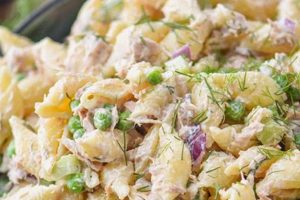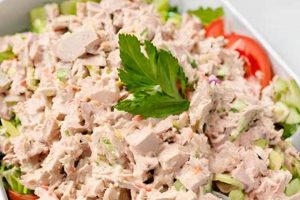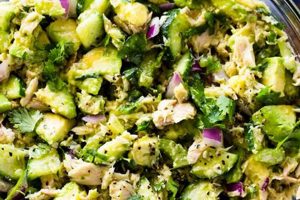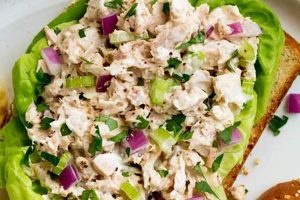A classic dish originating in Nice, France, this vibrant salad typically features fresh tuna, hard-boiled eggs, tomatoes, olives, green beans, potatoes, and anchovies, often served with a vinaigrette dressing. Variations may include other vegetables like artichoke hearts or bell peppers. A properly composed example showcases not just the individual ingredients but also their harmonious blend of flavors and textures: flaky tuna contrasting with crisp vegetables and briny olives, all brought together by a tangy dressing.
This culinary creation offers a nutritional powerhouse, providing lean protein, healthy fats, vitamins, and minerals. Its historical roots lie in the simple, ingredient-driven cuisine of the French Riviera, reflecting the region’s abundance of fresh produce and seafood. The dish’s enduring popularity speaks to its satisfying combination of flavor, nutrition, and visual appeal, making it a versatile option for a light lunch, a refreshing starter, or even a satisfying dinner.
Further exploration will delve into specific ingredient selections, preparation techniques, variations, and dressing options to guide the creation of this celebrated salad.
Tips for a Perfect Nioise Salad
Achieving an exemplary Nioise salad requires attention to detail and an understanding of the interplay between ingredients. The following tips offer guidance for creating a truly memorable dish.
Tip 1: Tuna Selection: Opt for high-quality, preferably fresh, tuna. Seared or grilled tuna steaks, sliced and arranged over the salad, elevate the dish. Canned tuna packed in olive oil can be a suitable alternative when fresh tuna is unavailable.
Tip 2: Vegetable Preparation: Slightly blanching green beans and potatoes ensures optimal texture, retaining a slight crispness. Tomatoes should be ripe but firm.
Tip 3: Egg Perfection: Achieving perfectly cooked hard-boiled eggs is essential. Avoid overcooking, which can result in a rubbery texture and a green ring around the yolk.
Tip 4: Anchovy Integration: Anchovies provide a crucial salty, umami element. High-quality anchovy fillets, either whole or chopped, contribute significantly to the overall flavor profile.
Tip 5: Olive Selection: Nioise olives, small and black, are traditional, but Kalamata olives offer a readily available substitute.
Tip 6: Vinaigrette Mastery: A classic vinaigrette, typically made with Dijon mustard, olive oil, red wine vinegar, and seasonings, enhances the salad’s flavors. Freshly prepared vinaigrette delivers the best results.
Tip 7: Presentation Matters: Arranging the ingredients thoughtfully elevates the dining experience. Consider creating a visually appealing composition with contrasting colors and textures.
By adhering to these guidelines, one can create a Nioise salad that showcases the harmonious balance of flavors and textures characteristic of this classic dish.
With these tips in mind, the following sections will explore specific variations and adaptations, offering further inspiration for culinary experimentation.
1. Fresh, High-Quality Tuna
Fresh, high-quality tuna stands as a cornerstone of an authentic and flavorful Nicoise salad. The tuna’s inherent flavor and texture significantly influence the overall culinary experience. Tuna possessing a deep red color, firm texture, and clean aroma indicates freshness and superior quality. Such attributes translate to a delectable, flaky texture and a delicate, nuanced flavor that complements, rather than overwhelms, the other salad components. Conversely, using lower-quality tuna, often characterized by a pale color and strong odor, can impart a fishy taste, detracting from the delicate balance of flavors within the salad. For example, sushi-grade tuna, known for its freshness and firm texture, elevates the salad to a gourmet experience. Conversely, canned tuna, while a viable option, may lack the nuanced flavor and textural complexity of fresh tuna, potentially diminishing the salad’s overall quality.
The choice of tuna preparation further impacts the salad’s character. Seared or lightly grilled tuna steaks, sliced and arranged atop the salad, offer a luxurious touch and a contrast in temperature and texture. These preparations highlight the tuna’s inherent flavor, creating a focal point within the dish. Alternatively, canned tuna packed in olive oil can be used, though it necessitates careful draining to avoid excess oiliness. Regardless of the preparation method, prioritizing fresh, high-quality tuna enhances the salad’s overall flavor profile and textural complexity. One could imagine a scenario where the delicate flavor of fresh tuna is overpowered by an overly strong vinaigrette if lower-quality tuna were used. The interplay of flavors and textures becomes crucial to a successful Nicoise salad.
Ultimately, the selection of fresh, high-quality tuna serves as a defining factor in the success of a Nicoise salad. The tuna’s contribution to the salad extends beyond mere protein; it establishes a foundation of flavor and texture upon which the other ingredients build. Understanding this connection allows for informed decisions regarding tuna selection and preparation, contributing to a truly exceptional culinary outcome. This attention to the quality of the core ingredient demonstrates a respect for the culinary tradition and ensures a more satisfying dining experience.
2. Properly Cooked Eggs
Properly cooked eggs constitute an essential component of a classic Tuna Nicoise salad, contributing not only visual appeal but also textural and flavor complexity. Their preparation, while seemingly simple, significantly impacts the overall dining experience. Overcooked or undercooked eggs can detract from the salad’s delicate balance, highlighting the importance of mastering this seemingly minor detail.
- Timing and Technique:
Achieving the perfect hard-boiled egg necessitates precise timing and appropriate cooking techniques. A properly cooked yolk boasts a firm yet creamy texture, devoid of any green discoloration around the edge, which indicates overcooking and a sulfurous odor. Methods such as steaming or using a pressure cooker offer greater control over the cooking process, reducing the risk of overcooking and ensuring a consistently smooth, creamy yolk. For example, steaming eggs for approximately 12 minutes typically yields a perfectly cooked yolk and a tender white. This precision ensures that the egg integrates seamlessly with the other salad components.
- Visual Appeal:
The visual presentation of the eggs contributes significantly to the salad’s overall aesthetic. Neatly sliced or quartered eggs, with their vibrant yellow yolks contrasting against the white, enhance the salad’s visual appeal. Conversely, poorly cooked eggs, with runny yolks or rubbery whites, detract from the presentation. A well-plated salad, featuring perfectly cooked eggs, enhances the dining experience, reflecting attention to detail and culinary expertise.
- Textural Contrast:
The texture of the egg provides a welcome contrast to the other ingredients in the salad. The firm yet yielding egg white complements the crisp vegetables and flaky tuna. A properly cooked yolk, with its smooth, creamy texture, offers a counterpoint to the briny olives and the tangy vinaigrette. This interplay of textures creates a more dynamic and satisfying culinary experience.
- Flavor Enhancement:
While subtle, the flavor of a properly cooked egg enhances the overall flavor profile of the salad. The richness of the yolk complements the tuna and the vinaigrette, adding depth to the dish. Overcooked eggs, however, can develop a slightly sulfurous flavor that detracts from the delicate balance of the salad. The egg’s subtle flavor underscores the importance of proper cooking techniques in preserving the integrity of the dish.
The proper preparation of eggs, therefore, plays a crucial, albeit often overlooked, role in creating a successful Tuna Nicoise salad. From their visual contribution to their textural and flavor enhancements, properly cooked eggs elevate this classic dish, transforming it from a simple assemblage of ingredients into a carefully orchestrated culinary experience. Mastery of this seemingly minor element speaks volumes about the chef’s attention to detail and respect for the culinary tradition.
3. Crisp blanched vegetables
Crisp blanched vegetables constitute a defining characteristic of a well-executed Tuna Nicoise salad, offering a textural counterpoint to the other ingredients while preserving their fresh flavors and vibrant colors. Blanching, a brief immersion in boiling water followed by an immediate ice bath, deactivates enzymes responsible for vegetable degradation, thereby maintaining optimal texture and color. This technique enhances the overall sensory experience of the salad. Green beans, a staple in Nicoise salad, benefit significantly from blanching. Without this step, they can possess a stringy texture and a raw, vegetal flavor that clashes with the other components. Blanched green beans, however, retain a vibrant green hue and offer a snappy texture, enhancing the salad’s overall appeal. Similarly, potatoes, another frequent addition, require proper cooking to achieve the desired texture. Blanching ensures they are tender yet firm, providing a satisfying contrast to the flaky tuna and other ingredients.
The importance of crisp blanched vegetables extends beyond mere texture. They contribute significantly to the salad’s nutritional value and overall flavor profile. Blanching preserves water-soluble vitamins, ensuring that the vegetables retain their nutritional benefits. Furthermore, the quick cooking process helps to maintain the vegetables’ fresh, bright flavors, preventing them from becoming dull or overcooked. Imagine a Nicoise salad with limp, overcooked green beans and mushy potatoesthe contrast in textures, crucial to the dish’s appeal, would be lost. The inclusion of crisp blanched vegetables, therefore, serves both a culinary and nutritional purpose, contributing to a well-rounded and satisfying dish.
In conclusion, the technique of blanching vegetables, although seemingly simple, plays a crucial role in achieving the desired texture, preserving nutrients, and enhancing the overall sensory experience of the Tuna Nicoise salad. This attention to detail elevates the dish, showcasing the importance of proper vegetable preparation in achieving culinary excellence. The interplay of textures and flavors, so characteristic of a well-made Nicoise salad, relies heavily on the inclusion of crisp, perfectly blanched vegetables. Their presence contributes to the balanced and harmonious composition of this classic dish.
4. Flavorful Olives and Anchovies
Flavorful olives and anchovies contribute essential briny, salty, and umami notes to a Tuna Nicoise salad, differentiating it from other salads. These ingredients, while small in size, play a significant role in establishing the salad’s characteristic flavor profile. Their careful selection and integration enhance the overall culinary experience, demonstrating a nuanced understanding of flavor balance and ingredient interaction.
- Olive Selection and Impact:
Olives provide a salty, briny counterpoint to the richness of the tuna and the acidity of the vinaigrette. Nicoise olives, small and black, are traditional; however, Kalamata olives offer a readily available and flavorful substitute. The choice of olive variety influences the salad’s overall flavor profile. Oil-cured olives introduce a subtle richness, while salt-cured olives offer a more intense brininess. The olive’s texture, whether firm or slightly wrinkled, also contributes to the salad’s sensory experience.
- Anchovy Integration and Flavor Enhancement:
Anchovies, often overlooked, provide a crucial umami element, adding depth and complexity to the salad. High-quality anchovy fillets, either whole or chopped, contribute a savory, salty flavor that balances the other ingredients. Their presence, while sometimes subtle, elevates the salad beyond a simple combination of ingredients. The quantity used requires careful consideration; too few anchovies may result in a bland salad, while too many can overpower the delicate flavors of the other components.
- Balancing Brininess and Acidity:
The combined brininess of the olives and anchovies must harmonize with the vinaigrette’s acidity. A vinaigrette that is too acidic can clash with the salty elements, while a bland vinaigrette fails to provide the necessary contrast. Achieving the correct balance requires careful consideration of the vinaigrette’s ingredients and proportions. For instance, a vinaigrette with a higher proportion of olive oil to vinegar may be preferred when using particularly salty olives or anchovies. This balance ensures that no single flavor dominates the salad.
- Ingredient Sourcing and Quality:
The quality of the olives and anchovies directly impacts the salad’s overall flavor. High-quality olives, packed in good quality oil or brine, possess a superior flavor and texture compared to those of lower quality. Similarly, oil-packed anchovy fillets typically offer a more delicate flavor and texture than salt-packed varieties. Sourcing ingredients from reputable suppliers ensures optimal flavor and enhances the overall culinary experience.
The combined effect of flavorful olives and anchovies elevates the Tuna Nicoise salad, transforming it from a simple combination of ingredients into a complex and nuanced culinary creation. Their strategic inclusion exemplifies the importance of considering each ingredient’s contribution to the overall flavor profile, demonstrating a sophisticated understanding of culinary balance and ingredient interaction. The careful selection and integration of olives and anchovies contribute significantly to the salad’s distinctive character and enduring appeal. A Tuna Nicoise salad without these key components lacks the characteristic depth of flavor that distinguishes it from other salads.
5. Balanced Vinaigrette
A balanced vinaigrette constitutes a crucial element of a successful tuna Nicoise salad recipe, serving to unify the diverse flavors and textures present. The vinaigrette’s role extends beyond simply dressing the salad; it acts as a critical binding agent, harmonizing the richness of the tuna, the brininess of the olives and anchovies, the earthiness of the potatoes, and the freshness of the vegetables. A poorly conceived vinaigrette, whether overly acidic, excessively oily, or bland, can disrupt this delicate balance, diminishing the salad’s overall appeal. Conversely, a well-balanced vinaigrette enhances the individual flavors of the components while simultaneously creating a cohesive culinary experience.
Consider a vinaigrette composed solely of olive oil and lemon juice. While seemingly simple, the high acidity of the lemon juice can overpower the delicate flavor of the tuna and clash with the briny olives. Adding a touch of Dijon mustard to this vinaigrette introduces a nuanced complexity, tempering the acidity while contributing a subtle tang. A pinch of sugar further balances the flavors, rounding out the sharpness of the lemon juice and creating a more harmonious blend. This example illustrates the impact of carefully considered proportions in achieving vinaigrette equilibrium. Furthermore, the quality of the ingredients also plays a significant role. Extra virgin olive oil, with its robust flavor, contributes more complexity than standard olive oil. Freshly squeezed lemon juice offers a brighter, more vibrant acidity compared to bottled varieties.
Achieving vinaigrette balance requires an understanding of flavor interactions and a willingness to experiment with different ingredient combinations and proportions. The ideal vinaigrette complements, rather than masks, the flavors of the other salad components. This balance ensures a harmonious and satisfying culinary experience, showcasing the interplay of flavors and textures characteristic of a well-executed tuna Nicoise salad. Failure to achieve this balance can result in a disjointed and less satisfying dish, highlighting the vinaigrette’s crucial role in unifying the diverse elements of this classic salad.
6. Thoughtful Presentation
Thoughtful presentation elevates the tuna Nicoise salad from a simple meal to a visually appealing culinary experience. Presentation encompasses the arrangement of ingredients, the choice of servingware, and the overall aesthetic appeal of the dish. Strategic placement of ingredients highlights their individual colors and textures, while appropriate servingware complements the salad’s composition. The visual appeal enhances the dining experience, stimulating appetite and creating a sense of anticipation.
- Ingredient Arrangement:
Consider the placement of each ingredient. Rather than simply tossing all components together, a deliberate arrangement creates visual interest. For example, fanning out slices of hard-boiled egg, arranging tomato wedges in a circular pattern, and strategically placing anchovy fillets creates a more dynamic and appealing presentation. This method showcases the variety of ingredients and their individual characteristics.
- Color Contrast and Balance:
The vibrant colors of the salad components offer an opportunity to create visual harmony. The deep red of the tuna, the bright green of the beans, the yellow of the egg yolks, and the dark purple of the olives create a natural color palette. Arranging these colors thoughtfully enhances the salad’s visual appeal. For instance, placing the tuna slices against a backdrop of green beans creates a striking contrast that draws the eye.
- Texture Variation and Height:
Varying textures and creating height adds dimension to the salad. The flaky tuna, the crisp vegetables, the smooth eggs, and the briny olives offer a range of textures. Creating height, by placing some ingredients, like the tuna or eggs, on top of the greens, adds visual interest and prevents the salad from appearing flat and uninspired.
- Servingware Selection:
The choice of servingware further influences the overall presentation. A shallow platter or individual plates showcase the salad’s components effectively. A white or light-colored plate provides a neutral backdrop that allows the vibrant colors of the salad to stand out. The size and shape of the servingware should complement the salad’s composition, enhancing its visual appeal.
In the context of a tuna Nicoise salad, thoughtful presentation transforms a collection of ingredients into a cohesive and visually captivating culinary creation. The interplay of colors, textures, and arrangement elevates the dining experience, stimulating the senses and creating a sense of occasion. This attention to detail distinguishes a thoughtfully prepared salad from a hastily assembled one, demonstrating an appreciation for both the culinary and aesthetic aspects of the dish. Ultimately, thoughtful presentation enhances the enjoyment of the tuna Nicoise salad, making it a more memorable and satisfying culinary experience.
7. Authentic Ingredient Sourcing
Authentic ingredient sourcing significantly impacts the flavor profile and overall quality of a tuna Nicoise salad. Utilizing ingredients reflective of the salad’s geographical originsthe coastal region of Nice, Franceenhances its authenticity and connection to culinary tradition. Sourcing high-quality tuna, preferably from the Mediterranean, ensures optimal flavor and texture. Likewise, opting for small, black Nicoise olives, even if more challenging to locate, contributes to the salad’s distinctive briny character. Employing locally sourced, seasonal produce, when feasible, further amplifies the salad’s freshness and flavor complexity. For example, sourcing tomatoes grown in a similar climate to Nice during their peak season intensifies their sweetness and enhances their contribution to the overall flavor profile. Conversely, using generic ingredients diminishes the salad’s authenticity and can result in a less nuanced, potentially bland, culinary experience. The difference between using canned tuna and fresh, line-caught tuna exemplifies this distinction. Fresh tuna offers a delicate flavor and firm texture that canned tuna often lacks.
The impact of authentic ingredient sourcing extends beyond flavor. It reflects a respect for culinary heritage and a commitment to preserving traditional techniques. Choosing ingredients reflective of the salad’s origins connects the dish to its historical context. For instance, using traditional French Dijon mustard in the vinaigrette, rather than a generic substitute, underscores this commitment to authenticity. This dedication to sourcing authentic ingredients elevates the salad from a simple meal to a culinary experience that honors its cultural roots. The effort invested in sourcing authentic ingredients ultimately translates to a more satisfying and nuanced dish, one that resonates with both flavor and culinary history.
In conclusion, authentic ingredient sourcing plays a pivotal role in creating a truly exceptional tuna Nicoise salad. Prioritizing ingredients reflective of the salads origins enhances its flavor, texture, and connection to culinary tradition. While practical considerations may necessitate some substitutions, striving for authenticity, whenever possible, results in a more satisfying and nuanced culinary experience, demonstrating a respect for the dish’s history and a commitment to culinary excellence. This dedication enriches not only the final product but also the process of creation, fostering a deeper appreciation for the art of culinary craftsmanship.
Frequently Asked Questions
This section addresses common inquiries regarding the preparation and enjoyment of tuna Nicoise salad.
Question 1: What type of tuna is most suitable for this salad?
While fresh, high-quality tuna, such as sushi-grade yellowfin or bluefin, is ideal, canned tuna packed in olive oil offers a viable alternative. The choice depends on availability and budget constraints.
Question 2: Can other vegetables be substituted for the traditional ingredients?
While deviations from the classic recipe are possible, substituting core ingredients like green beans and potatoes significantly alters the salad’s character. Additions, such as bell peppers or artichoke hearts, can complement the traditional components without compromising the salad’s essence.
Question 3: Is it necessary to blanch the green beans and potatoes?
Blanching enhances the texture and color of these vegetables, rendering them tender-crisp while preserving their vibrant hues. Omitting this step can result in a less appealing and potentially less flavorful salad.
Question 4: What can be used in place of anchovies if one has an aversion to them?
Anchovies contribute a crucial salty, umami element. While omitting them alters the traditional flavor profile, capers or a small amount of finely chopped Kalamata olives can provide a degree of brininess. Alternatively, a sprinkle of sea salt can enhance the overall salinity.
Question 5: What is the best way to store leftover tuna Nicoise salad?
Storing leftover salad components separately and combining them just before serving preserves their individual textures and flavors. The vinaigrette should also be stored separately and added just prior to consumption.
Question 6: Can the tuna Nicoise salad be prepared in advance?
While certain components, such as the hard-boiled eggs and blanched vegetables, can be prepared ahead of time, assembling the salad just before serving ensures optimal freshness and prevents the vegetables from becoming soggy. The vinaigrette can also be prepared in advance and stored separately.
Understanding these common points of inquiry ensures a more informed approach to preparing and enjoying this classic dish.
The following section offers variations on the classic recipe, providing further inspiration for culinary exploration.
Tuna Nicoise Salad Recipe
This exploration of the tuna Nicoise salad recipe has delved into the essential components and techniques that contribute to its enduring appeal. From the selection of fresh, high-quality tuna to the careful balancing of the vinaigrette, each element plays a crucial role in the final composition. Proper preparation of vegetables, thoughtful inclusion of olives and anchovies, and attention to presentation further elevate this classic dish. Authentic ingredient sourcing, while not always feasible, enhances the connection to culinary tradition and amplifies the overall dining experience. Understanding these nuances allows for a deeper appreciation of the salad’s complexity and its enduring presence in culinary history.
The tuna Nicoise salad stands as a testament to the power of simple, fresh ingredients combined with thoughtful preparation. It offers a versatile and satisfying culinary experience, adaptable to various occasions and palates. Further exploration of regional variations and individual ingredient preferences promises continued culinary discovery and a deeper appreciation of this timeless classic.






